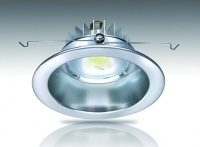
Seren Photonics, an ultra-high efficiency LED company, is commercialising the work of Tao Wang, a reader in the Department of Electronic and Electrical Engineering at Sheffield University.
The technique, which relies on nanoscience and fundamental physics, allows gallium nitride LEDs to more efficiently convert energy into light.
While he would not give specific details about the technique, Wang said his process fabricates gallium nitride devices with fewer defects. A semiconductor’s defects can trap electrons and prevent them from converting into photons, reducing the efficiency of an LED.
Wang said the cause of these defects stems from the way gallium nitride is grown. The quality of a semiconductor crystal is best when it is grown on a substrate made of the same material. The trouble with gallium nitride is that gallium nitride substrates are too expensive for mass production, so manufacturers have instead used substrates made of sapphire, which shrinks and cools at the same rate as gallium nitride.
Yet even with advanced techniques it is very difficult to grow premium-quality gallium nitride crystals on sapphire. While other researchers are developing improved methods of growing these crystals, Wang has developed a technique that turns gallium nitride crystals – regardless of their quality – into LEDs with fewer defects than any currently on the market.
Wang said his LEDs have twice the efficiency of any LEDs available, meaning that when voltage is put into them, twice the number of electrons convert into photons.
Also, because his technique can work with any gallium nitride crystal quality, it can significantly reduce production costs. This means LEDs may become affordable enough for use in offices and homes.
Seren Photonics aims to completely replace fluorescent tubes, which have low efficiency and short lives compared with LEDs, which can remain switched on for approximately 100,000 hours. The firm is also targeting white LED markets such as back lighting for laptops and TVs, as well as signs and displays.




Swiss geoengineering start-up targets methane removal
No mention whatsoever about the effect of increased methane levels/iron chloride in the ocean on the pH and chemical properties of the ocean - are we...